Yichen Xie
DeSiRe-GS: 4D Street Gaussians for Static-Dynamic Decomposition and Surface Reconstruction for Urban Driving Scenes
Nov 18, 2024



Abstract:We present DeSiRe-GS, a self-supervised gaussian splatting representation, enabling effective static-dynamic decomposition and high-fidelity surface reconstruction in complex driving scenarios. Our approach employs a two-stage optimization pipeline of dynamic street Gaussians. In the first stage, we extract 2D motion masks based on the observation that 3D Gaussian Splatting inherently can reconstruct only the static regions in dynamic environments. These extracted 2D motion priors are then mapped into the Gaussian space in a differentiable manner, leveraging an efficient formulation of dynamic Gaussians in the second stage. Combined with the introduced geometric regularizations, our method are able to address the over-fitting issues caused by data sparsity in autonomous driving, reconstructing physically plausible Gaussians that align with object surfaces rather than floating in air. Furthermore, we introduce temporal cross-view consistency to ensure coherence across time and viewpoints, resulting in high-quality surface reconstruction. Comprehensive experiments demonstrate the efficiency and effectiveness of DeSiRe-GS, surpassing prior self-supervised arts and achieving accuracy comparable to methods relying on external 3D bounding box annotations. Code is available at \url{https://github.com/chengweialan/DeSiRe-GS}
X-Drive: Cross-modality consistent multi-sensor data synthesis for driving scenarios
Nov 02, 2024



Abstract:Recent advancements have exploited diffusion models for the synthesis of either LiDAR point clouds or camera image data in driving scenarios. Despite their success in modeling single-modality data marginal distribution, there is an under-exploration in the mutual reliance between different modalities to describe complex driving scenes. To fill in this gap, we propose a novel framework, X-DRIVE, to model the joint distribution of point clouds and multi-view images via a dual-branch latent diffusion model architecture. Considering the distinct geometrical spaces of the two modalities, X-DRIVE conditions the synthesis of each modality on the corresponding local regions from the other modality, ensuring better alignment and realism. To further handle the spatial ambiguity during denoising, we design the cross-modality condition module based on epipolar lines to adaptively learn the cross-modality local correspondence. Besides, X-DRIVE allows for controllable generation through multi-level input conditions, including text, bounding box, image, and point clouds. Extensive results demonstrate the high-fidelity synthetic results of X-DRIVE for both point clouds and multi-view images, adhering to input conditions while ensuring reliable cross-modality consistency. Our code will be made publicly available at https://github.com/yichen928/X-Drive.
TrajSSL: Trajectory-Enhanced Semi-Supervised 3D Object Detection
Sep 17, 2024Abstract:Semi-supervised 3D object detection is a common strategy employed to circumvent the challenge of manually labeling large-scale autonomous driving perception datasets. Pseudo-labeling approaches to semi-supervised learning adopt a teacher-student framework in which machine-generated pseudo-labels on a large unlabeled dataset are used in combination with a small manually-labeled dataset for training. In this work, we address the problem of improving pseudo-label quality through leveraging long-term temporal information captured in driving scenes. More specifically, we leverage pre-trained motion-forecasting models to generate object trajectories on pseudo-labeled data to further enhance the student model training. Our approach improves pseudo-label quality in two distinct manners: first, we suppress false positive pseudo-labels through establishing consistency across multiple frames of motion forecasting outputs. Second, we compensate for false negative detections by directly inserting predicted object tracks into the pseudo-labeled scene. Experiments on the nuScenes dataset demonstrate the effectiveness of our approach, improving the performance of standard semi-supervised approaches in a variety of settings.
Optimizing Diffusion Models for Joint Trajectory Prediction and Controllable Generation
Aug 01, 2024



Abstract:Diffusion models are promising for joint trajectory prediction and controllable generation in autonomous driving, but they face challenges of inefficient inference steps and high computational demands. To tackle these challenges, we introduce Optimal Gaussian Diffusion (OGD) and Estimated Clean Manifold (ECM) Guidance. OGD optimizes the prior distribution for a small diffusion time $T$ and starts the reverse diffusion process from it. ECM directly injects guidance gradients to the estimated clean manifold, eliminating extensive gradient backpropagation throughout the network. Our methodology streamlines the generative process, enabling practical applications with reduced computational overhead. Experimental validation on the large-scale Argoverse 2 dataset demonstrates our approach's superior performance, offering a viable solution for computationally efficient, high-quality joint trajectory prediction and controllable generation for autonomous driving. Our project webpage is at https://yixiaowang7.github.io/OptTrajDiff_Page/.
Sparse Diffusion Policy: A Sparse, Reusable, and Flexible Policy for Robot Learning
Jul 01, 2024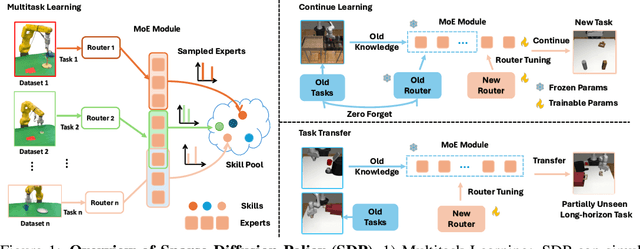

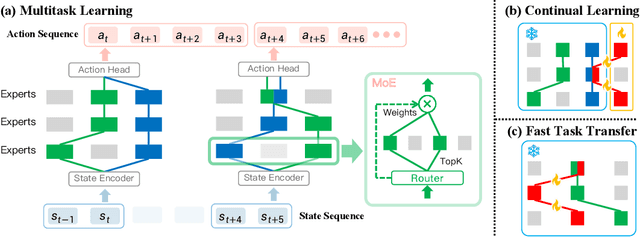

Abstract:The increasing complexity of tasks in robotics demands efficient strategies for multitask and continual learning. Traditional models typically rely on a universal policy for all tasks, facing challenges such as high computational costs and catastrophic forgetting when learning new tasks. To address these issues, we introduce a sparse, reusable, and flexible policy, Sparse Diffusion Policy (SDP). By adopting Mixture of Experts (MoE) within a transformer-based diffusion policy, SDP selectively activates experts and skills, enabling efficient and task-specific learning without retraining the entire model. SDP not only reduces the burden of active parameters but also facilitates the seamless integration and reuse of experts across various tasks. Extensive experiments on diverse tasks in both simulations and real world show that SDP 1) excels in multitask scenarios with negligible increases in active parameters, 2) prevents forgetting in continual learning of new tasks, and 3) enables efficient task transfer, offering a promising solution for advanced robotic applications. Demos and codes can be found in https://forrest-110.github.io/sparse_diffusion_policy/.
RoadBEV: Road Surface Reconstruction in Bird's Eye View
Apr 09, 2024Abstract:Road surface conditions, especially geometry profiles, enormously affect driving performance of autonomous vehicles. Vision-based online road reconstruction promisingly captures road information in advance. Existing solutions like monocular depth estimation and stereo matching suffer from modest performance. The recent technique of Bird's-Eye-View (BEV) perception provides immense potential to more reliable and accurate reconstruction. This paper uniformly proposes two simple yet effective models for road elevation reconstruction in BEV named RoadBEV-mono and RoadBEV-stereo, which estimate road elevation with monocular and stereo images, respectively. The former directly fits elevation values based on voxel features queried from image view, while the latter efficiently recognizes road elevation patterns based on BEV volume representing discrepancy between left and right voxel features. Insightful analyses reveal their consistence and difference with perspective view. Experiments on real-world dataset verify the models' effectiveness and superiority. Elevation errors of RoadBEV-mono and RoadBEV-stereo achieve 1.83cm and 0.56cm, respectively. The estimation performance improves by 50\% in BEV based on monocular image. Our models are promising for practical applications, providing valuable references for vision-based BEV perception in autonomous driving. The code is released at https://github.com/ztsrxh/RoadBEV.
Boundary Matters: A Bi-Level Active Finetuning Framework
Mar 15, 2024



Abstract:The pretraining-finetuning paradigm has gained widespread adoption in vision tasks and other fields, yet it faces the significant challenge of high sample annotation costs. To mitigate this, the concept of active finetuning has emerged, aiming to select the most appropriate samples for model finetuning within a limited budget. Traditional active learning methods often struggle in this setting due to their inherent bias in batch selection. Furthermore, the recent active finetuning approach has primarily concentrated on aligning the distribution of selected subsets with the overall data pool, focusing solely on diversity. In this paper, we propose a Bi-Level Active Finetuning framework to select the samples for annotation in one shot, which includes two stages: core sample selection for diversity, and boundary sample selection for uncertainty. The process begins with the identification of pseudo-class centers, followed by an innovative denoising method and an iterative strategy for boundary sample selection in the high-dimensional feature space, all without relying on ground-truth labels. Our comprehensive experiments provide both qualitative and quantitative evidence of our method's efficacy, outperforming all the existing baselines.
ActiveAD: Planning-Oriented Active Learning for End-to-End Autonomous Driving
Mar 05, 2024Abstract:End-to-end differentiable learning for autonomous driving (AD) has recently become a prominent paradigm. One main bottleneck lies in its voracious appetite for high-quality labeled data e.g. 3D bounding boxes and semantic segmentation, which are notoriously expensive to manually annotate. The difficulty is further pronounced due to the prominent fact that the behaviors within samples in AD often suffer from long tailed distribution. In other words, a large part of collected data can be trivial (e.g. simply driving forward in a straight road) and only a few cases are safety-critical. In this paper, we explore a practically important yet under-explored problem about how to achieve sample and label efficiency for end-to-end AD. Specifically, we design a planning-oriented active learning method which progressively annotates part of collected raw data according to the proposed diversity and usefulness criteria for planning routes. Empirically, we show that our planning-oriented approach could outperform general active learning methods by a large margin. Notably, our method achieves comparable performance with state-of-the-art end-to-end AD methods - by using only 30% nuScenes data. We hope our work could inspire future works to explore end-to-end AD from a data-centric perspective in addition to methodology efforts.
Rethinking Classifier Re-Training in Long-Tailed Recognition: A Simple Logits Retargeting Approach
Mar 01, 2024



Abstract:In the long-tailed recognition field, the Decoupled Training paradigm has demonstrated remarkable capabilities among various methods. This paradigm decouples the training process into separate representation learning and classifier re-training. Previous works have attempted to improve both stages simultaneously, making it difficult to isolate the effect of classifier re-training. Furthermore, recent empirical studies have demonstrated that simple regularization can yield strong feature representations, emphasizing the need to reassess existing classifier re-training methods. In this study, we revisit classifier re-training methods based on a unified feature representation and re-evaluate their performances. We propose a new metric called Logits Magnitude as a superior measure of model performance, replacing the commonly used Weight Norm. However, since it is hard to directly optimize the new metric during training, we introduce a suitable approximate invariant called Regularized Standard Deviation. Based on the two newly proposed metrics, we prove that reducing the absolute value of Logits Magnitude when it is nearly balanced can effectively decrease errors and disturbances during training, leading to better model performance. Motivated by these findings, we develop a simple logits retargeting approach (LORT) without the requirement of prior knowledge of the number of samples per class. LORT divides the original one-hot label into small true label probabilities and large negative label probabilities distributed across each class. Our method achieves state-of-the-art performance on various imbalanced datasets, including CIFAR100-LT, ImageNet-LT, and iNaturalist2018.
Cohere3D: Exploiting Temporal Coherence for Unsupervised Representation Learning of Vision-based Autonomous Driving
Feb 23, 2024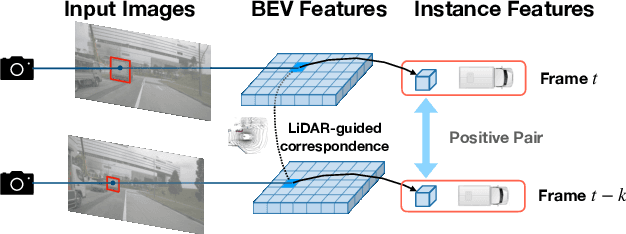
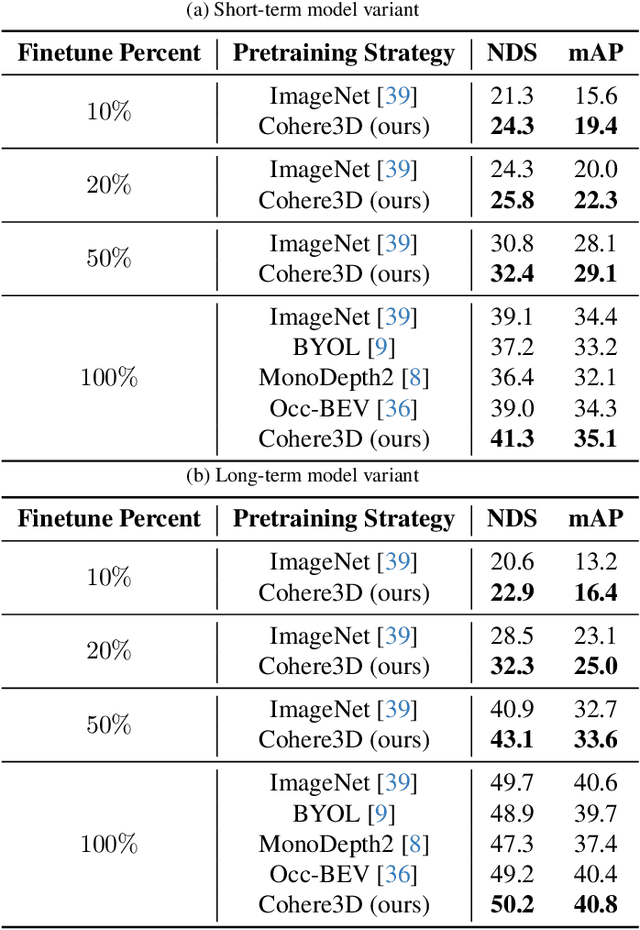
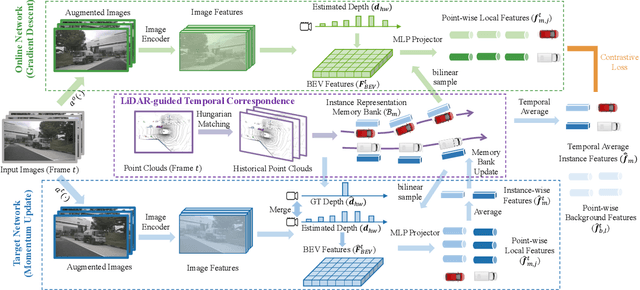

Abstract:Due to the lack of depth cues in images, multi-frame inputs are important for the success of vision-based perception, prediction, and planning in autonomous driving. Observations from different angles enable the recovery of 3D object states from 2D image inputs if we can identify the same instance in different input frames. However, the dynamic nature of autonomous driving scenes leads to significant changes in the appearance and shape of each instance captured by the camera at different time steps. To this end, we propose a novel contrastive learning algorithm, Cohere3D, to learn coherent instance representations in a long-term input sequence robust to the change in distance and perspective. The learned representation aids in instance-level correspondence across multiple input frames in downstream tasks. In the pretraining stage, the raw point clouds from LiDAR sensors are utilized to construct the long-term temporal correspondence for each instance, which serves as guidance for the extraction of instance-level representation from the vision-based bird's eye-view (BEV) feature map. Cohere3D encourages a consistent representation for the same instance at different frames but distinguishes between representations of different instances. We evaluate our algorithm by finetuning the pretrained model on various downstream perception, prediction, and planning tasks. Results show a notable improvement in both data efficiency and task performance.
 Add to Chrome
Add to Chrome Add to Firefox
Add to Firefox Add to Edge
Add to Edge